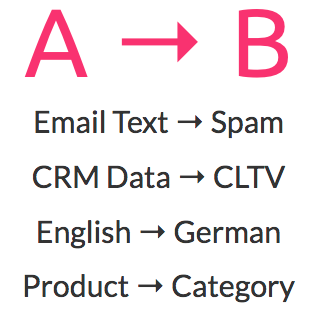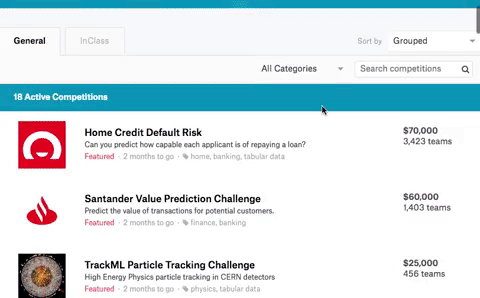Ready to learn Artificial Intelligence? Browse courses like Uncertain Knowledge and Reasoning in Artificial Intelligence developed by industry thought leaders and Experfy in Harvard Innovation Lab.
How AI works. What you can do with it. And how to get started.

AI is all about connecting A to B
Information on AI is often confusing and sometimes downright misleading. But AI for business is simple:
“99% of the economic value created by AI today is through one type of AI, which is learning A to B or input to output mappings.” Andrew Ng
Almost every business application of AI today is about learning to produce certain outputs from certain inputs:

How does AI learn to predict the correct output?
- You collect examples of input –> output pairs (the more the better).
- The AI algorithm learns the connection between input and output (that’s the magic).
- You apply the trained algorithm (the “model”) to new input data to predict the correct output.
That’s it! Almost everyone who uses AI to make $$ does it exactly like this.
Use AI when you have a lot of data
AI needs data
AI is powerful because it turns data into insights. But AI is less efficient at learning than people are (yes, way less efficient), so it needs a lot of data in order to learn. If you have lots of data, you should think about AI!
Data is a competitive advantage, not Algorithms.
That’s why Google and Facebook have no problem open sourcing their algorithms. But they definitely don’t open source their data. If you have a lot of data no one else has, then that’s the perfect opportunity to build a unique AI system.
The 3 simplest ways to find your AI use cases
So you have a lot of data. Now what do you do? Here are the 3 best ways I know to discover AI use cases:
1. Improve automated decision-making
Where do you have software that automates rule-based decisions?
For example:
- Call Routing
- Credit Scoring
- Image Classification
- Marketing Segmentation
- Product Classification
There is a good chance AI can improve the accuracy of these decisions, because AI models can capture more of the underlying complexity that connects A to B. By comparison, when you write rules into software manually (the traditional way), you can only encode rudimentary dependencies.
For one of our clients (ImmobilienScout24), we increased revenue from emails by 250%. By simply replacing rule-based email segmentation with smarter, and more fine-tuned AI-based segmentation.
2. Things people can do in < 1 second
Another great heuristic I first heard from Andrew Ng is:
“Pretty much anything that a normal person can do in <1 sec, we can now automate with AI.” Twitter
So what are some things humans can decide in < 1 sec?
- Who’s in that picture?
- Do I have a good feeling about this potential customer?
- Does this look like a problematic CT Scan?
Also many jobs are a sequence of < 1 sec decisions. Like driving:
- Is that person going to cross the street?
- Am I too close to the sidewalk?
- Should I slow down?
- … and many, many more.
Anything you can do in less than 1 second, AI can most likely do too (or it will be able to soon).
3. Get inspired by Kaggle competitions

Large corporations like Zillow, Avito, Home Depot, Santander, Allstate and Expedia are running data science competitions on Kaggle. These are challenges they want outside data scientists to solve. So these competitions give you an idea of what types of AI solutions they are working on. It’s really a great resource.
Have a look at the competitions and get inspired.
TL;DR: Finding AI Use Cases:
- Upgrade decision-making that’s already automated
- Automate things people do in < 1 sec
- Get inspired by Kaggle competitions
Don’t wait until you have a Data Science Team
Building a good data science team is super hard (and expensive!)
Many companies struggle (and ultimately fail) to build an efficient data science team. Why is it so hard?
- Misinformation about who to hire
- Tough competition for talent
- Few managers who can lead data science teams effectively
What’s more…
You don’t know yet whether you need a data science team
You might have a lot of data and a lot of ideas, but that doesn’t mean you need your own data science team. Only after you’ve built your first AI systems will you really know how much manpower you’ll need in the long run. So…
Build something that works – fast
Your first goal should be to pick the lowest hanging AI fruit and finish it quickly. This gets you miles ahead:
- You’ll achieve tangible success that gets investors, the board, and your team excited;
- You’ll get to know the taste of AI and get real-life experience of what works and what doesn’t;
- You’ll have better ideas about where to use AI next.
With that first finished system under your belt, you are in a much better position to hire and train a data science team. Or maybe you find that you don’t want (or need) to hire a whole team, because that low-hanging fruit already accounted for 80% of what you can feasibly do with AI.
AI teams should work across the whole company
If you do build an AI team, you should build it for the whole company, not just one department. A horizontal AI team.
Don’t think in departments
AI experience is very transferable: To a data scientist, your CRM data looks almost the same as your inventory data. And to an algorithm, they look even more similar. So it makes a lot of sense to build one AI task force for the whole firm.
Side note: For that to work, you should also have your data in one place!
More life-saving tips

Don’t listen to people selling a “better algorithm”
Either they have no experience, or they’re trying to sell you open source for a markup. In AI, everyone is cooking with water, meaning they’re using publically available algorithms.
Focus on business experience & engineering quality
Work with someone who takes the time to really understand the business problem you’re trying to solve and has high standards when it comes to engineering quality. If you want lots of results with fewer headaches, then the plumbing is more important than the cute algorithm that flows through it.
Magic Triangle meetings
The best ideas develop when you put three types of people in a room:
- Someone who’s in touch with the current business priorities (you?),
- Someone who knows the data you have (your database engineer), and
- Someone who has lots of practical experience building AI systems.
Together, these three people can make realistic plans, really fast.
TL;DR
So that’s it:
- AI is about connecting A to B.
- Look into processes that involve a lot of data and < 1 sec decisions.
- Get a first win before you plan big.



